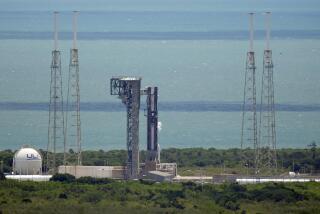Ozone Experiment Partly Successful : Shuttle Test Device’s Short-Circuit Is Fixed
- Share via
HOUSTON — A major experiment developed to study the Earth’s outer atmosphere fizzled to a stop aboard the space shuttle Challenger Thursday, but not until it had sent back more information than had ever before been compiled on how industrial man is changing the delicate ozone layer.
And, later Thursday, Pasadena scientist-astronaut Taylor Wang announced triumphantly that, after three painstaking days of electrical work, he had fixed another experiment package, the $3.5-million Drop Dynamics Module, which short-circuited on the first day of the Challenger flight.
“It’s working! It’s working!” Wang said joyously after power surged to the instrument.
The failed ozone experiment, called ATMOS, is one of 15 experiments aboard the $1-billion, European-built Spacelab, which is making its second trip aloft on this 17th shuttle mission.
Gas Leak Detected
Its failure had been expected, because the ground crew at Johnson Space Center detected a slow gas leak in the ATMOS laser on Monday, the day the 4.5-million-pound shuttle roared aloft from Florida’s Kennedy Space Center.
Had the ATMOS carried on through the complete seven-day mission, it would have compiled 60 readings. But NASA officials said that the most they now expect is 19. Nevertheless, scientists called the experiment a major success. Dr. George Fichtl, the mission scientist, said that the information retrieved exceeded all atmospheric data recorded by all weather balloon flights and study from the Earth.
“It will take years to analyze,” he said.
Dr. Barney Farmer, the principal investigator for the project, said Thursday afternoon that the ATMOS had been able to measure solar radiation passing through the atmosphere and calculate the amount of each of 40 different gases in the upper atmosphere. Study of the data should give scientists the makeup of the atmosphere from Earth to 75 miles up.
Further Study Planned
Farmer said that that will serve as the basis for further study, because the ATMOS is scheduled to be sent into space each year for the next 10. Comparisons will then determine how much the ozone is being affected by gases produced on Earth.
Thursday’s major cause for elation on the shuttle and at the Johnson Space Center here was the repair of Wang’s experiment package, designed to test the effects of sound waves on weightless liquids. The machine had short-circuited when Wang first tried to start it, and he had been working laboriously to repair it ever since.
“I refuse to come home until I get this thing fixed,” he said early in the day.
It is still unclear whether Wang’s machine will perform as it is supposed to, because power has been reduced by a third. But, at least Wang, whose frustration showed in conversations with ground control, will get a chance to try.
Tests of Cosmic Rays
The Challenger crew continued to wrestle with other problems. An experiment designed to test the makeup of cosmic rays failed, and astronaut Don Lind, making his first spaceflight after 19 years as an astronaut, was attempting to get the mechanism working.
And there was still the nettlesome problem of the Challenger’s space menagerie--two squirrel monkeys and two dozen rats--whose cages have leaked clouds of food and feces.
Cleaning the cages and changing the food has been a constant irritation since liftoff. It was less so Thursday, but rodent droppings did manage to escape as astronauts Norman E. Thagard and Lodewijk van den Berg worked with a vacuum cleaner and plastic bags to avoid the showers of weightless debris in the Spacelab that had occurred the previous two days.
“It’s really quite a mess when you pull these old food canisters out,” Thagard said.
One monkey that earlier had been somewhat lethargic appeared improved Thursday. Paul Callahan, the experiment’s principal investigator, said that the rats were moving about vigorously, and the monkey was drinking more, indicating that it was recovering from what was apparently a minor case of space sickness.
“Overall, we’ve had a very positive, significant day,” Fichtl said.






